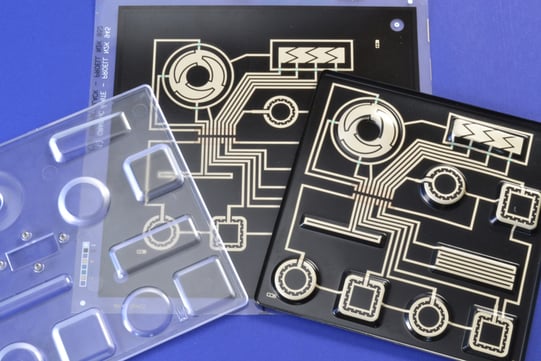Part 1: Inconsistent Printing Quality
As the demand for printed electronics continues to grow, manufacturers face a significant challenge—scaling up production efficiently while maintaining product quality and cost-effectiveness. To do so successfully, you must first understand the most common challenges companies experience. Then, we can walk through solutions to make the transition into larger volumes more seamless, and therefore, less costly. To make this easier to digest, we are going to take it one step at a time. First up, let’s talk about why manufacturers may face inconsistent printing quality, and what can be done about it.

One of the most pressing challenges when scaling up printed electronics production is maintaining consistent printing quality. As production volumes increase, variations in ink deposition, alignment, and curing processes can lead to defects and inconsistencies in the final product.
Challenges of Maintaining Printing Quality
- Increased Complexity and Variability: While production volume increases, the complexity and variability of the printing process tend to increase as well. Factors such as substrate properties, environmental conditions, and equipment parameters can introduce variations in ink deposition, registration, and curing. These variations can result in inconsistent resistance, ink thickness tolerance issues, and a decrease in overall yields.
- Screen Printer and Screen Maintenance: In high-volume production, the printing equipment suffers more wear and tear and requires frequent monitoring. Over time, this can lead to issues like inconsistent squeegee pressure, circuit misalignment, feeding problems due to static, premature screen wear, and general cosmetic defects. Regular maintenance becomes essential to ensure consistent printing quality, which can decrease downtime and operational costs.
- Ink and Material Consistency: The consistency of conductive inks and other materials is crucial for reliable printed electronics production. Variations in ink viscosity, particle size, and composition can lead to changes in electrical properties, affecting the performance of printed circuits. Consistent substrate thickness and overall dimensions are also critical. Many substrates are pre-treated to “bake-in” the shrinkage before going to production.
- Alignment and Registration Challenges: Achieving precise alignment and registration of multiple ink layers is critical for multi-layer printed electronics. As production scales up, ensuring accurate registration becomes more complex, especially when dealing with flexible substrates or intricate designs.
- Curing and Drying Processes: Proper curing or drying of printed layers is essential to achieve the desired electrical and mechanical properties. Scaling up production may require adjustments to curing processes, which can affect the uniformity of curing across large substrates or continuous rolls. Achieving faster throughput can be limited by the dwell time (time and temperature) especially when thicker ink laydown is desired. The temperature can only be increased to a certain degree due to the substrate. Time is limited to the length of tunnel oven and belt speed.
Solutions for Inconsistent Printing Quality
- Real-time Monitoring and Control: Does your manufacturer utilize real-time monitoring systems that continuously track key printing parameters, such as ink viscosity, temperature, and alignment? This can help identify and rectify variations as they occur.
- Automation and Robotics: Integrating automation and robotics into the printing process can enhance accuracy and consistency, particularly for tasks like substrate handling, alignment, and inspection.
- Quality Control Protocols: Never overlook the importance of a good defense. Talk with your manufacturer about their quality control protocols, including regular testing and inspection procedures. You will want to work with someone who has developed a strong, comprehensive plan to identify and address inconsistencies before they impact the final product. Having the right safeguards in place could prevent costly mistakes.
- Standardization, Maintenance, and Training: Standardizing processes and providing training to operators can minimize human errors and ensure that the printing process is carried out consistently across shifts and production lines. You’ll want to do your due diligence when choosing a supplier. As with most manufacturing processes, preventative maintenance is critical to keep your equipment at peak performance and insure the highest quality products are produced. A thorough PM program is a must.
- Materials Engineering and Supply: Working closely with material suppliers to develop tailor-made inks and substrates with consistent properties can reduce variations caused by material inconsistencies. This will also help to combat potential shelf-life issues as well as unique storage requirements such as refrigeration.
Addressing the challenge of inconsistent printing quality when scaling up printed electronics production requires a combination of advanced technologies, process optimization, and rigorous quality control measures. By working with a manufacturing partner who will proactively identify and mitigate sources of variability, you can ensure your large-scale production efforts will result in high-quality, reliable printed electronic components and devices.




.jpg?width=176&height=56&name=MR_associatedNetwork_logo%20(1).jpg)